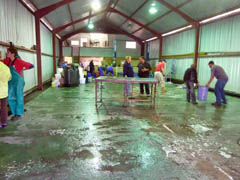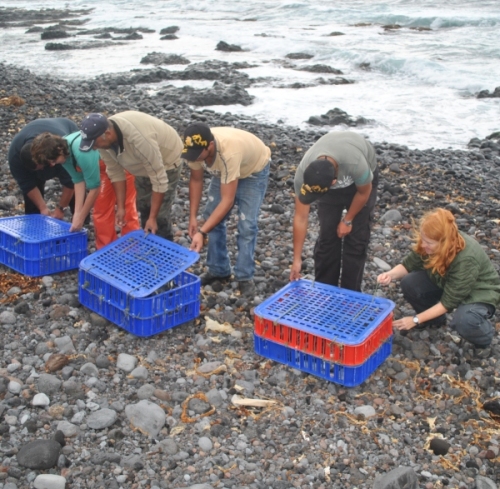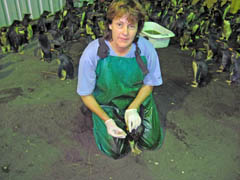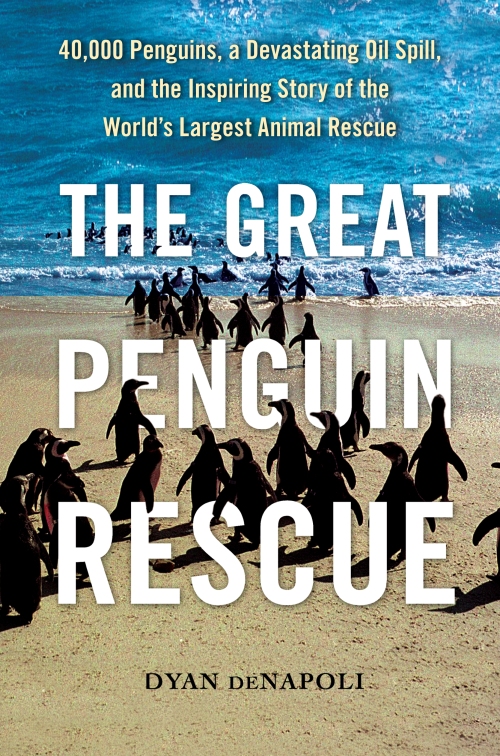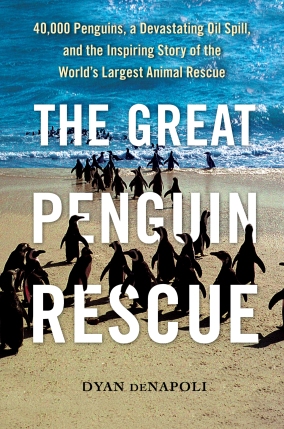The latest reports indicate that the recovery of any more oiled penguins from the islands in the Tristan da Cunha island group has probably concluded. Conservation officials on the islands have said they believe that all of the live oiled penguins have now been collected and brought to the rehabilitation center on the main island (Tristan da Cunha). This temporary rehabilitation center was constructed after supplies and staff from SANCCOB (Cape Town’s seabird rescue center) arrived on the tug, Svitzer Singapore, on April 5th. Extremely rough seas made it nearly impossible to access several of the islands over the last week or two, but now that a helicopter has arrived (as of last Tuesday on the Russian research vessel, the Ivan Papanin), they should be able to conduct more thorough surveys of the islands. The good news is that the rough seas have helped to break up the oil in the waters surrounding the islands.

Five ships at Tristan da Cunha - the most ever seen there at once. A helicopter is on the ship on the right, the Ivan Papanin. Photo by Katrine Herian, RSPB
Once the Svitzer Singapore arrived from Cape Town with frozen fish and cleaning supplies (including detergent, wash-tubs, degreaser, toothbrushes, hot water heaters and infrared heat lamps), the training of volunteers and cleaning of the oiled penguins could finally begin. Which was a tremendous relief. However, these birds had been coated in toxic oil for so long that they were in a very compromised state. In the past week, 1,577 of the 3,718 oiled penguins died. At this point, the exact cause of these deaths has not been released.

SANCCOB CEO Venessa Strauss spraying degreaser onto an oiled Rockhopper penguin prior to washing it. Photo by Katrine Herian, RSPB

Washing a Rockhopper penguin at Tristan da Cunha. Photo by Katrine Herian, RSPB
But we do know the following from previous experience; an oiled animal will compulsively preen or groom itself (a penguin uses its beak to do this) so they ingest the toxic oil covering their bodies. This leads to dehydration, anemia (the red blood cells lyse or break down, and the birds also get bleeding ulcers), and other health issues. Eventually, this long-term exposure to the toxic oil can kill them. So, the ideal situation is to get the penguins washed as soon as possible once they have been oiled (after first giving them 24-48 hours to stabilize after being captured and transported).
But, unfortunately, due to circumstances beyond the control of the islanders and the conservation officers stationed there (and the penguin experts coming from Cape Town), the necessary supplies did not arrive until three weeks after the oil spill occurred. The hold-up was apparently on the governmental level in the UK (this island group is a British territory). We still do not have answers as to why the official response from the UK was so slow and insufficient. Had professional rescue teams (bringing necessary supplies) been allowed to go to Tristan as soon as this oil spill occurred, the lives of many more penguins would undoubtedly have been saved.

Heavily oiled, emaciated penguin rescued on March 23rd. Photo by Katrine Herian
The timing of this oil spill also was disastrous for the penguins because they were just completing their annual molts (during which they fast for 2-3 weeks), and were already extremely thin to begin with. Before the Svitzer Singapore arrived with 20 tons of frozen sardines, islanders fished for local fish to feed the penguins – and even donated all of the fish in their personal freezers to the cause. According to the latest reports, the islanders are doing a wonderful job washing the penguins and nursing them back to health under the direction of the professional rescue teams. For more on the recent updates, you can read last week’s article from BirdLife International Community, titled Wash and dry for rockhoppers at rehab center. This page from the official Tristan da Cunha website also has updated reports: Seabird Rehabilitation on Tristan da Cunha main island.

Islanders cutting up fish they had caught to feed the oiled penguins.
So several questions remain; How many penguins died on the islands or at sea before they could be collected or counted? How many of the rescued penguins will survive, and how many will continue to breed after being rehabilitated and released? How will this oil spill impact the future survival of this endangered species? How will it affect the local ecology of this island group? Will the oil enter the food chain, thus affecting the penguins and other seabirds further? At this point, the local lobster fishery has been shut down due to oil contamination. This fishery is the primary source of income for the 270 islanders living on Tristan da Cunha. How will this oil spill impact the islanders as well?
Until the penguins return in August for the next breeding season, we won’t realize the full impact of this oil spill. Even then, we still won’t have all of the answers to these questions. But, when they do return (after spending months feeding at sea in preparation for the breeding season), conservation officers on the islands will be able to conduct nest counts, which should give us some indication of how many penguins might have been lost that were not accounted for at this time. To fully understand the long-term impact the MS Oliva oil spill will have on this pristine region, and on the endangered Northern Rockhopper penguins, will require long-term monitoring. This project will require a great deal of funding – and it will not be covered by the ship’s insurers.

Hand-feeding a thin, oiled Rockhopper penguin at Tristan da Cunha. Photo by Estelle van der Merwe
The following organizations have set up special fundraisers for the rescue, rehabilitation and future monitoring of the Rockhopper penguins at Tristan da Cunha. PLEASE DONATE GENEROUSLY TO HELP THE PENGUINS! Thank you!
The Ocean Doctor (Dr. David Guggenheim): http://oceandoctor.org/ (Click on the green ‘donate now’ button in the right-hand column.) Or go to this link:Nightingale Island Disaster Penguin and Seabird Rescue Fund
Royal Society for the Protection of Birds: Nightingale Island Emergency Appeal
Foundation for Antarctic Research: Catastrophic Oil Spill – Tristan
Dyan deNapoli (The Penguin Lady) – author of The Great Penguin Rescue


